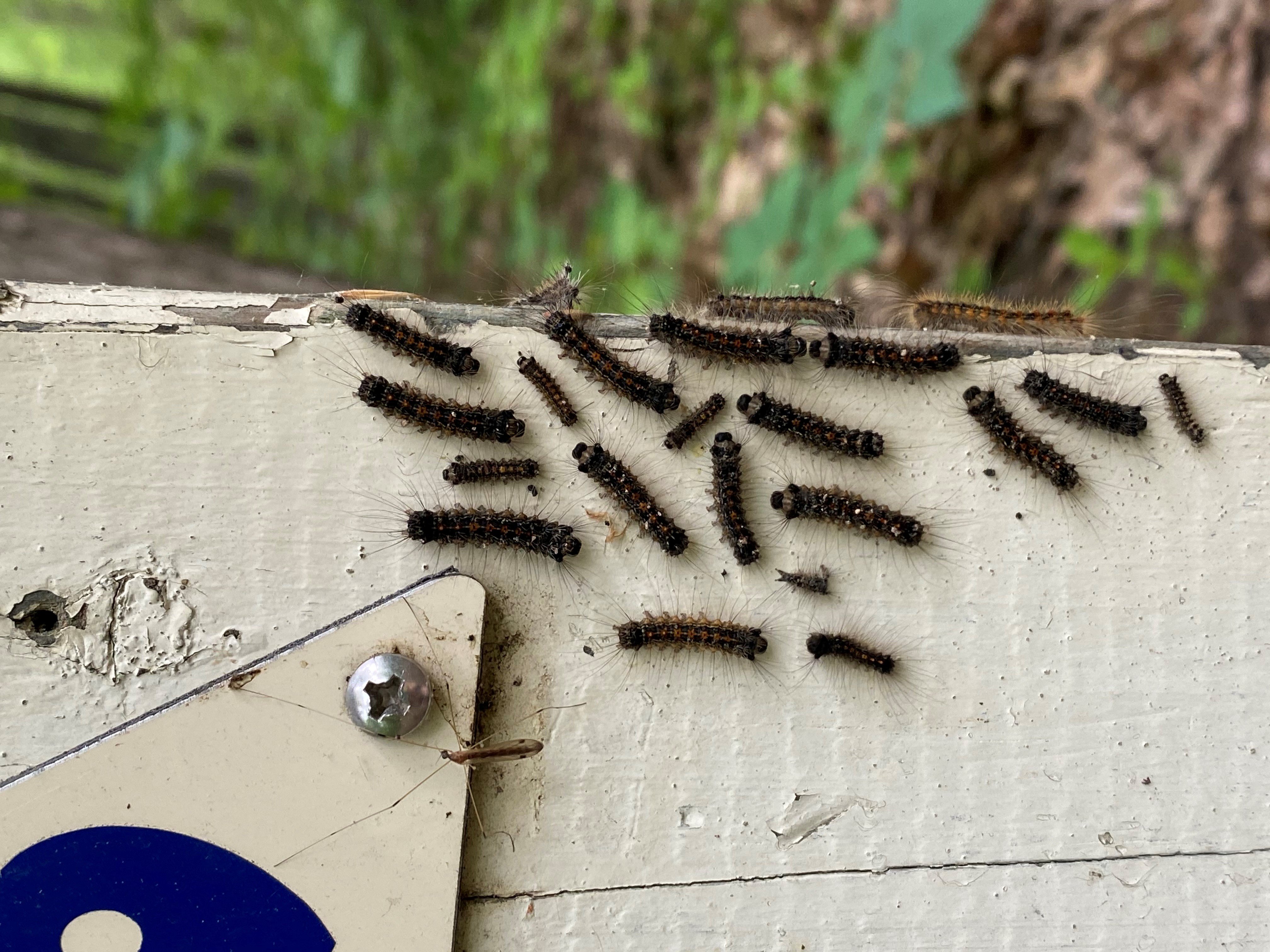What can you do to manage Lymantria dispar in your landscape?
Having problems with Lymantria dispar, formerly gypsy moth, this summer? You aren't alone!

Much of Michigan‘sLower Peninsula is experiencing an outbreakofLymantria dispar, formerly gypsy moth, an exotic pest. Lymantria dispar caterpillars feed on the leaves of oaks, aspen and many other kinds of trees.
Local outbreaks of Lymantria dispar generally collapse after three or perhaps four years. Two pathogens, including a nucleopolyhedrosis virus (NPV), and a fungal disease calledEntomophaga maimaiga, are especially important at causing Lymantria dispar outbreaks to collapse. These two insect diseases will not affect people, pets or beneficial insects like pollinators or insect predators. Over time, NPV will increase in a population and affect more and more Lymantria dispar caterpillars. Effects of the fungal disease on Lymantria dispar populations can also be important but vary depending on spring temperatures and rainfall.

Living in the midst of a Lymantria dispar outbreak is not pleasant. There will be a few weeks when large caterpillars and their “frass” (excrement) are abundant. Fortunately, the caterpillars will finish feeding by early or mid-July, usually right around July 4. At that point, they will spin reddish-brown cocoons, pupate, and adult moths will emerge. Neither the male nor female moths do any feeding. After mating, the females lay an egg mass then die.

Some trees, including many oaks, aspen, basswood, apple and willows, can be completely defoliated during Lymantria dispar outbreaks. However, most of these trees will recover. Deciduous trees (hardwoods) that lose more than 50-60% or more of their leaves will re-flush and produce a second set of leaves, usually by late July. Producing a second set of leaves can stress the tree but is unlikely to threaten the life of an otherwise healthy deciduous tree. Ensuring trees receive one inch of water per week, either from rain or from supplemental water, is important for helping trees recover from defoliation.
Note that occasionally Lymantria dispar caterpillars will feed on the needles of conifer trees (evergreens). Conifers such as spruce, pine, fir, and hemlock cannot re-flush during the summer and are more vulnerable than deciduous trees to defoliation. If caterpillars consume all or nearly all of their needles, the trees will die. If Lymantria dispar caterpillars are feeding on conifers, control efforts are warranted.
What can you do?
Michigan State University Extensionreceives frequent inquiries about Lymantria dispar identification, impacts and management options for landscape trees. Our first recommendation is to ensure the insect iscorrectly identified. There are many insects that feed on trees but there is only one Lymantria dispar!
While living with Lymantria dispar may be unpleasant,the caterpillars typically only feed for four to six weeks. People can choose to tolerate the caterpillars until they pupate, usually by early to mid-July.
Other options to help protect landscape trees can also be considered. For example, Lymantria dispar egg masses can be physically removed and soaked in soapy water for 24-48 hours to kill the eggs. It is best to wait until fall and winter to scrape egg masses. This allowstiny wasps to develop inside the Lymantria dispar eggs. Those little parasitoid wasps will help reduce Lymantria dispar populations next year.
Burlap barrier bandscan be wrapped around a tree trunk. The caterpillars will hide under the flap of burlap during the day. Every day or so, knock the caterpillars into a bucket of soapy water to kill them. While this will not affect the overall Lymantria dispar population, it can help protect an individual tree. Sticky bands wrapped around the trunk are sometimes used to prevent caterpillars from crawling up to the canopy to feed on leaves. Avoid applying the sticky material directly to the bark – it can injure the tree. Three or four bands of inside-out duct tape around the trunk can also help capture the caterpillars.
Individuals or neighborhoods may consider hiring an arborist to spray or to inject individual trees with insecticides registered for use on Lymantria dispar. Proper equipment and experienced applicators will be important to effectively control the caterpillars and reduce effects on non-target insects and the environment. Various insecticide products are available for homeowners and non-commercial users to apply to trees on their own property. Follow all label instructions. Some insecticides use the microbial insecticide Btk. This is anaturally occurring bacteria calledBacillus thuringiensisvar.kurstakithat only affects caterpillars that consume leaves that are sprayed with Btk. These products, however, are most likely to be effective if young caterpillars are targeted, usually around mid or late May.
You can find a comprehensive list of resources on Lymantria dispars linked throughout this article at the MSU Integrated Pest Management website://www.alltkd.com/ipm/Invasive_species/Gypsy-Moth/. Or simply Google “MSU Lymantria dispar” and click on the topics of interest.
密西根州立大学扩展英蒂可以帮助工作人员和志愿者viduals with questions about Lymantria dispar and their landscapes. Clients are asked to upload their question and up to three photos at Ask Extension (//www.alltkd.com/outreach/ask-an-expert). These inquiries can be submitted any time. The MSU Extension Lawn and Garden hotline is available from 9 a.m. to noon on Mondays, Wednesdays and Fridays (1-888-678-3464). Engaging directly with an arborist (https://www.treesaregood.org/) is recommended for those who wish to have assistance on site.



 Print
Print Email
Email
